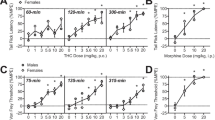Summary
-
1.
The psychopharmacological activity of Δ 1-tetrahydrocannabinol, (I); Δ 1(6)-tetrahydrocannabinol (4′ hexyl), (II); Δ 1(6)-tetrahydrocannabinol, (III); 1-ethoxyhexahydrocannabinol, (IV); 8-ethoxy-iso-hexahydrocannabinol, (V); Δ 1(6)-tetrahydrocannabinolic acid Me ester, Isomer I, (VI); Δ 1(6)-tetrahydrocannabinolic acid Me ester, Isomer II, (VII); cannabigerol, (VIII); Δ 1(6)-tetrahydrocannabinol (3′ hexyl), (IX); cannabichromene, (X); has been examined in a variety of animal species.
-
2.
Compounds (I) and (III) caused severe motor disturbances and a stuporous state in dogs and ptosis, “tameness” and peculiar postural changes in monkeys. In the latter animal, compound (II) elicited similar effects.
-
3.
Compounds (I) and (III) after intraperitoneal but not subcutaneous administration, suppressed the gerbil digging activity; reduced the rat conditioned avoidance response and induced a cataleptoid reaction in mice, rats and gerbils. In addition, compound (I) reduced the performance of mice on the rotating-rod. Both compounds, administered subcutaneously, induced a measurable ataxic gait in rats.
-
4.
Amphetamine reversed the behavioural changes elicited by compounds (I) and (III) in monkeys, as well as the cataleptoid reaction in rats.
-
5.
None of the other compounds provoked observable changes in any of the species studied.
-
6.
It is suggested that Rhesus monkeys might serve as a suitable model for assessing the psychopharmacological activity of active cannabinoids.
Similar content being viewed by others
References
Bovet, D., G. L. Gatti, and M. Frank: An automatic device for the study of conditioned escape reactions in the rat. I. A programming and recording method for establishing learning, retention and deconditioning curves. Sci. Repts. Ist. Super. Sanità 1, 127–138 (1961).
Dunham, N. W., and T. S. Miya: A note on a simple apparatus for detecting neurological deficit in rats and mice. J. Amer. pharm. Ass., sci. Ed. 46, 208 (1957).
Gaoni, Y., and R. Mechoulam: Isolation, structure and partial synthesis of an active constituent of hashish. J. Amer. chem. Soc. 86, 1646 (1964).
— —: Hashish. VI. The isomerization of cannabidiol to tetrahydrocannabinols. Tetrahedron 22, 1481–1488 (1966).
Garattini, S.: Effects of a cannabis extract on gross behaviour. In: Hashish: its chemistry and pharmacology. CIBA Foundation Study Group No. 21, pp. 70–78. Eds.: G. E. W. Wolstenholme and J. Knight. London: J. & A. Churchill 1965.
Garriott, J. C., L. J. King, R. B. Forney, and F. W. Hughes: Effects of some tetrahydrocannabinols on hexobarbital sleeping time and amphetamine induced hyperactivity in mice. Life Sci. 6, 2119–2128 (1967).
Grunfeld, Y., and H. Edery: Psychopharmacological activity of some substances extracted from Cannabis sativa L. (Hashish). Abst. Proc. Israel Physiol. Pharmacol. Soc. 16th Scient. Meeting, Jerusalem (1968).
Hively, R. L., W. A. Mosher, and F. W. Hoffmann: Isolation of trans-Δ 6-tetrahydrocannabinol from marijuana. J. Amer. chem. Soc. 88, 1832–1833 (1966).
Hofmann, A.: Psychotomimetic agents. In: Drugs affecting the central nervous system. Medicinal Research, Vol.2, pp. 169–235. Ed.: A. Burger. New York: Dekker 1968.
Isbell, H., C. W. Gorodetzsky, D. Jasinski, U. Claussen, F. V. Spulak, and F. Korte: Effects of (−)-Δ9-trans-tetrahydrocannabinol in man. Psychopharmacologia (Berl.) 11, 184–188 (1967).
Joachimoglu, G.: Natural and smoked hashish. In: Hashish: its chemistry and pharmacology. CIBA Foundation Study Group No. 21, pp. 2–11. Eds.: G. E. W. Wolstenholme and J. Knight. London: J. & A. Churchill 1965.
Kalir, A., D. Baldermann, H. Edery, and G. Porath: 7-methoxyindole and its derivatives. Israel J. Chem. 5, 129–136 (1967).
H. Edery, Z. Pelah, D. Balderman, and G. Porath: 1-phenylcycloalkylamine derivatives. Part II. Synthesis and pharmacological activity. J. med. Chem. (in press) (1969).
Loewe, S.: Pharmacological study. In: The marihuana problem in the city of New York. Mayors Committee on Marihuana, pp. 149–212. Lancaster, Pennsylvania: Jacques Cattell Press 1944.
—: Studies on the pharmacology and acute toxicity of compounds with marihuana activity. J. Pharmacol. exp. Ther. 88, 154–161 (1946).
—: Cannabiswirkstoffe und Pharmakologie der Cannabinole. Naunyn-Schmiedebergs Arch. exp. Path. Pharmak. 211, 175–193 (1950).
Mechoulam, R., and Y. Gaoni: Recent advances in the chemistry of hashish. Fortschr. Chem. org. Nat.-Stoffe 25, 175–213 (1967).
—, B. Yagnitinsky, and Y. Gaoni: Stereoelectronic factor in the chloranil dehydrogenation of cannabinoids. Total synthesis of dl-cannabichromene. J. Amer. chem. Soc. 90, 2418–2420 (1968).
Naftali, J., and J. Wolf: Notes on breeding experiments with the albino strain of meriones tristrami Thomas 1829. Bull. Res. Coun. Israel 5 B, 189–191 (1955).
Norton, S.: Behavioural patterns as a technique for studying psychotropic drugs. In: Psychotropic drugs, pp. 73–82. Eds.: S. Garattini and V. Ghetti. Amsterdam: Elsevier 1957.
Porath, G., and H. Edery: Psychopharmacological actions and effects on smooth muscle of some substituted indolealkylamines. Proc. Israel Physiol. Pharmacol. Soc. 1, 9 (1965).
Rushton, R., H. Steinberg, and C. Tinson: Effects of a single experience on subsequent reactions to drugs. Brit. J. Pharmacol. 20, 90–105 (1963).
Walton, R. P., L. F. Martin, and J. H. Keller: The relative activity of various purified products obtained from american grown hashish. J. Pharmacol. exp. Ther. 62, 239–251 (1938).
Wolstenholme, G. E. W., and J. Knight: Hashish: its chemistry and pharmacology. CIBA Foundation Study Group No. 21. London: J. & A. Churchill 1965.
Author information
Authors and Affiliations
Rights and permissions
About this article
Cite this article
Grunfeld, Y., Edery, H. Psychopharmacological activity of the active constituents of hashish and some related cannabinoids. Psychopharmacologia 14, 200–210 (1969). https://doi.org/10.1007/BF00404218
Received:
Issue Date:
DOI: https://doi.org/10.1007/BF00404218




